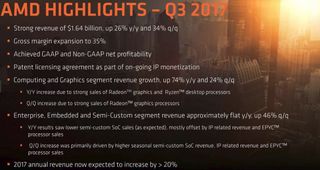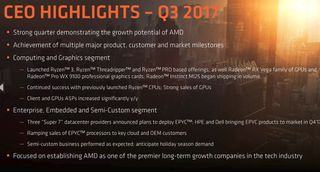AMD Posts Banner Q3 Financial Results; Returns To Profitability, But Stock Drops
AMD posted its first profit in three years during yesterday's third quarter 2017 financial results. Highlights of AMD's banner quarter include a $71 million GAAP profit, which comes largely due to a 74% increase in its Computing and Graphics segment to $819 million.
AMD doesn't break out processor and graphics earnings separately, but the company said the increases mostly came from Ryzen and Radeon sales. AMD CEO Lisa Su noted that client computing revenue has increased by a "strong double-digit percentage" and that the company has reached 40% to 50% desktop processor share with some e-tailers.

AMD's sales weighed in at $1.64 billion, beating estimates by $130 million. Revenue is up 26% year-over-year and 34% quarter-over-quarter, and the company expects to beat its previous yearly profit projections of "mid-to-high teens" percentage to 20%.
With all of these good vibes, we'd expect AMD's stock to trade at record levels. However, AMD predicted that its sales would decrease 12 to 18% in the next quarter, which the company chalks up to seasonality (Q3 is always stronger than Q4) and the resulting slump in semi-custom revenue (primarily chips destined for game consoles).
As a result of the lowered expectations, AMD's shares, which have jumped 115% this year alone, have dropped 13.5% at the time of writing.
Much of the investor angst stems from a Citi Research sell rating for AMD's stock, and earlier this week the firm predicted that AMD's shares would fall 60% due to Intel's Coffee Lake processors. Obviously, the firm feels that AMD's processors aren't competitive enough against Intel's latest.
But AMD has a 12nm LPP FinFET process shrink scheduled for next year, which could bring up to 10% performance improvement over the existing process. AMD confirmed that it would use the new process in both graphics and processors, so it will likely have a response ready for Intel's Coffee Lake processors soon.
Stay on the Cutting Edge
Join the experts who read Tom's Hardware for the inside track on enthusiast PC tech news — and have for over 25 years. We'll send breaking news and in-depth reviews of CPUs, GPUs, AI, maker hardware and more straight to your inbox.
The signs of the company's efforts made an appearance in AMD's financials. The company has raised its R&D spend by 20% year-over-year. Su said the company intends to increase R&D spending linearly with revenue, so we might see a slight dip next quarter due to the reduced forecast.
A few other interesting tidbits popped up during the call, as well. AMD closed a patent licensing transaction that helped boost profit but didn't provide further details. This transaction isn't like the China-based Tianjin Haiguang Technology Investment Co. Ltd. (THATIC) agreement the company entered last year. AMD's stock jumped over 300% last year following its announcement that it's sharing CPU (including Zen) and SoC technology through its THATIC venture.
"So we did say that the IP transaction was a patent licensing related transaction. So that's different from the technology licensing, for example, that we did with THATIC. This was a straight patent licensing. And the great thing about our patent portfolio is beyond sort of our core markets, it has applicability across a broad range of markets. And so this was a patent transaction and not a technology licensing transaction," said Lisa Su (via Seeking Alpha).
Given the nature of the transaction, it's doubtful this represents confirmation of the long-running rumor that Intel will incorporate AMD's graphics technology.
AMD's Wafer Supply Agreement is a key enabler for the company that guarantees enough wafers for production, but although AMD is committed to the Global Foundries relationship, it isn't exclusive. AMD has options to procure wafers from other fabs if needed. As we reported last year, AMD has to essentially pay a fine to Global Foundries if it sources from other fabs. That came into play as well.
"Gross margin was 35%, up 4 percentage points year-over-year, primarily driven by the benefit of IP-related revenue and a richer mix from the Computing and Graphics segment, which were partially offset by costs associated with our global foundries wafer supply agreement for wafers purchased at another foundry," said Davinder Kumar (via Seeking Alpha).
AMD didn't disclose the mystery fab, but it is widely believed to be TSMC. It also isn't clear if the wafers are destined for Ryzen processors, which might be due to a surge in demand.
AMD is also furthering its EPYC data center initiative, but that long-term investment will take time to come to fruition. AMD has several wins with major hyperscalers, such as Baidu, Tencent, and Microsoft Azure. HP Enterprise and Dell also have plans to deploy their first market-ready platforms in Q4, which should boost EPYC's market penetration.

Overall, AMD has a solid future roadmap. The company continues to significantly benefit from the advent of blockchain (mining) on the graphics side, but the investing community is clearly skittish about the threat from Intel's revamped processors. Given that Intel's Coffee Lake processors are almost impossible to purchase, that might not be as much of a threat in the next few months. But there will be a pitched battle for desktop sockets as we move into next year.

Paul Alcorn is the Managing Editor: News and Emerging Tech for Tom's Hardware US. He also writes news and reviews on CPUs, storage, and enterprise hardware.
-
tyns78 From an investment standpoint, AND is a wet dog with fleas. Stock is dramatically overvalued, their agreement with GloFo is a yoke around their necks, and the reason they don't split out graphics financials from CPU (they did until recently) is because the graphics unit consistently hemorrhages cash.Reply
Feel free to cheer on the company for their products, but don't make the mistake with your investments. Citi's $5 target is too low simply because the irrational investors will keep it propped under higher, but I wouldn't be a buyer over $10, probably closer to $8 -
InvalidError Reply
Profit from GPUs is going to soar from datacenter, AI and other compute demand. AMD itself landed a few deals for such projects this year with Vega.20309062 said:and the reason they don't split out graphics financials from CPU (they did until recently) is because the graphics unit consistently hemorrhages cash.
Unfortunately for gamers, this means gaming GPUs are going to become second-rate priorities for Nvidia and AMD's budgets. Expect the gap between new architectures for datacenters and benefits from those new architectures trickling down to consumer GPUs to widen.
-
nitrium Reply
I don't know how the internals breakdown, but you would think the fact that BOTH of the major consoles running their GPUs would be significant(?). I'm guessing the next-gen consoles will also almost certainly go AMD for backward compatibility reasons. Or is AMD just about subsidising Microsoft and Sony to convince them to use AMD parts?20309062 said:the reason they don't split out graphics financials from CPU (they did until recently) is because the graphics unit consistently hemorrhages cash.
-
TJ Hooker Reply
Console chips are under AMD's "Semi-custom" category, which is separate from desktop/laptop CPUs/GPUs. So they wouldn't affect those financials.20309659 said:
I don't know how the internals breakdown, but you would think the fact that BOTH of the major consoles running their GPUs would be significant(?). I'm guessing the next-gen consoles will also almost certainly go AMD for backward compatibility reasons. Or is AMD just about subsidising Microsoft and Sony to convince them to use AMD parts?20309062 said:the reason they don't split out graphics financials from CPU (they did until recently) is because the graphics unit consistently hemorrhages cash. -
nitrium Reply
Ok. But then losses in the GPU sector would be offset by sales in "Semi-custom" sector, since they can't possibly provide the latter without investing in the former. So analysis of the internals aren't as simple as stating the "graphics unit consistently haemorrhages cash", right?20309732 said:Console chips are under AMD's "Semi-custom" category, which is separate from desktop/laptop CPUs/GPUs. So they wouldn't affect those financials.
-
hannibal The better income has allowed the amd to increase funds to development and that is good!Reply -
mapesdhs Reply20309260 said:Unfortunately for gamers, this means gaming GPUs are going to become second-rate priorities for Nvidia and AMD's budgets. Expect the gap between new architectures for datacenters and benefits from those new architectures trickling down to consumer GPUs to widen.
The Good Old Gamer posted an interesting video about this issue back in May:
https://www.youtube.com/watch?v=PkeKx-L_E-o
Ian.
-
Martell1977 Reply20309062 said:the reason they don't split out graphics financials from CPU (they did until recently) is because the graphics unit consistently hemorrhages cash.
This comment is so backward it's stunning. You do realize that the GPU department is the only reason AMD didn't file bankruptcy years ago. They kept the company going while bulldozer and it's derivatives were their CPU architecture.
Plus, I think you underestimate the shear numbers of GPU's they are selling. Even at inflated prices, demand has been insane. Whether it's gamers or miners, the GPU's are barely ever in stock, anywhere, meaning they are flying off the shelves as fast as they can produce them.
Ryzen is a great product, but AMD can't rush another launch the way Intel did with Coffee, and that lead that Intel has is what is making investors nervous. They are afraid that Intel will open a performance gap again they way it was with bulldozer. Which AMD can't afford.
Until Ryzen, the CPU department was hemorrhaging cash. -
redgarl A lot of people trying to put logic between the drop in stock and AMD numbers... well, guess what, there is none. AMD is the stock that is the most speculative on Wall street because the potential is huge. AMD is one of the two companies working on GPU which is driving AI.Reply
The next 10 years are going to be better than the 10 last. It's obvious especially that AMD is switching at 7nm and launching new silicon in 2019. The GloFo deal will payoff 2018, unfortunately, not before. -
knowom Citi Research sell rating by 60% based on Coffee Lake is crazy. Ryzen 1600/1700 are the best value for dollar. You need to take into account the motherboard cost which for Ryzen is far less costly than it's counterpart. Relative CPU performance across programs is much higher compared to similarly prices Intel CPU's. The one strong point for Coffee Lake is higher refresh rate displays which is primarily only 1080p. Once you move up to 1440p and 4K the results disappear as the refresh rate and FPS no longer becomes the bottleneck.Reply
I think more of it stems from unfair skepticism of Vega that is selling like candy despite it's modestly luke warm mediocre game performance overall at present however as DX becomes more prolific it certainly evens out a bit more nicely. Vega also has the crypto currency play which could or could not start to wane, but probably safe to say won't overnight. It's not just that however Vega basically annihilates Nvidia at 3D content creation and they just added support for like what 12 GPU's RENDER FARMS???? CRYPTO FARMS???? either way...they got a lot going on plus Thread Ripper and Epyc as well and APU that's off the charts and 7nm on the horizon.
I think they analysts have blind folds on right now in regard to what's about to happen with AMD over the next 2-3 years. It feels like they are about to enter into another AMD64 type of era of success. That is what my gut tells me. A lot of analysts weren't so keen on Nvidia back when CUDA was relatively new either for the record and boy were they ever wrong dragging the brakes on that steam engine railroading across country.
Most Popular



